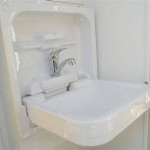Understanding the Bathroom Sink Drain Stopper Mechanism
The bathroom sink drain stopper mechanism is a seemingly simple device, yet it plays a crucial role in the functionality of the bathroom sink. Its primary purpose is to effectively seal the drain opening, allowing the sink to be filled with water for various tasks, such as washing hands, shaving, or cleaning small items. Conversely, it provides a means to quickly and efficiently drain the water when no longer needed. A malfunctioning stopper can lead to frustrating issues like slow draining, leaks, or the inability to retain water in the sink. Therefore, understanding the components, operation, common problems, and maintenance of these mechanisms is essential for both homeowners and plumbing professionals.
Different types of drain stoppers exist, each employing a slightly different mechanism to achieve the same basic function. The most common types include the pop-up stopper, the lift-rod stopper, the twist-and-turn stopper, and the toe-touch stopper. Each type has its own advantages and disadvantages in terms of ease of use, reliability, susceptibility to clogs, and ease of repair. The choice of stopper often depends on the design of the sink and faucet, as well as personal preference.
Key Components and Operation Principles
Regardless of the specific type, most bathroom sink drain stopper mechanisms share some common components. These typically include the stopper itself, a pivot rod, a clevis, and a lift rod (or other actuating mechanism). The stopper is the part that physically seals the drain opening. The pivot rod is a horizontal rod that connects to the stopper and allows it to move up and down. The clevis is a connector that links the pivot rod to the lift rod. The lift rod, which is usually located behind the faucet, is the control mechanism that the user operates to raise and lower the stopper.
The typical operation involves the user manipulating the lift rod (or twisting, pushing, or toe-tapping, depending on the type of stopper). This action causes the pivot rod to rotate. The rotation of the pivot rod, in turn, moves the stopper either up, opening the drain, or down, sealing the drain. The clevis provides the necessary connection and leverage to translate the vertical motion of the lift rod into the rotational motion of the pivot rod. The design and arrangement of these components are crucial for ensuring smooth and reliable operation of the stopper.
The precise mechanics vary depending on the specific stopper type. For example, a pop-up stopper often has a spring-loaded mechanism that allows it to be pressed down to seal the drain and pressed again to release it. A twist-and-turn stopper operates by rotating the stopper itself to lock it in the open or closed position. In all cases, the principle remains the same: converting an external action into the controlled movement of the stopper to either seal or open the drain.
Common Problems and Troubleshooting
Bathroom sink drain stopper mechanisms are prone to various problems, primarily due to the accumulation of hair, soap scum, and other debris within the drain and around the moving parts. This buildup can hinder the movement of the stopper, pivot rod, and clevis, leading to slow draining or a complete blockage. In some cases, the stopper may become permanently stuck in either the open or closed position.
One common issue is a loose or disconnected lift rod. If the lift rod becomes detached from the clevis, the user will be unable to control the stopper. This can often be resolved by simply reattaching the lift rod to the clevis and tightening any associated screws. Another frequent problem is a misaligned pivot rod. If the pivot rod is not properly aligned with the stopper, the stopper may not seal correctly or may be difficult to move. Adjusting the position of the pivot rod can often resolve this issue. Additionally, the clevis itself can become corroded or broken over time, requiring replacement.
Slow draining is a common symptom of a clogged drain stopper mechanism. This is usually caused by the accumulation of hair and debris around the stopper and pivot rod. Cleaning the drain and removing the debris can often restore proper drainage. In more severe cases, it may be necessary to disassemble the drain stopper mechanism to thoroughly clean all of the components. This typically involves removing the stopper, pivot rod, and clevis, and then cleaning them with a brush and a drain cleaner.
Leaks around the drain stopper are another common problem. These leaks can occur due to a worn or damaged rubber seal on the stopper, a loose connection between the drain flange and the sink, or cracks in the drainpipe. Replacing the rubber seal, tightening the drain flange, or repairing the drainpipe can often resolve these leaks.
Maintenance and Prevention
Regular maintenance is crucial for preventing problems with bathroom sink drain stopper mechanisms and ensuring their continued reliable operation. The most important aspect of maintenance is regular cleaning to remove hair, soap scum, and other debris that can accumulate in the drain and around the moving parts. This can be done periodically using a drain cleaner or by manually removing the debris with a small hook or wire.
One effective preventative measure is to install a drain strainer or screen over the drain opening. This will catch hair and other debris before they enter the drain, reducing the likelihood of clogs. The strainer should be cleaned regularly to prevent it from becoming clogged itself.
Another important aspect of maintenance is ensuring that all of the components of the drain stopper mechanism are properly lubricated. This will help to reduce friction and wear, and prevent the parts from becoming stuck or corroded. A silicone-based lubricant can be applied to the pivot rod, clevis, and other moving parts. This should be done periodically, especially if the stopper is becoming difficult to move.
Periodically inspect the drain stopper mechanism for signs of wear or damage. This includes checking the rubber seal on the stopper for cracks or deterioration, inspecting the pivot rod and clevis for corrosion or breakage, and ensuring that all of the connections are tight. Any worn or damaged parts should be replaced promptly to prevent further problems.
When performing any maintenance or repairs on the drain stopper mechanism, it is important to turn off the water supply to the sink to prevent flooding. It is also important to use the correct tools and techniques to avoid damaging the components. If you are not comfortable performing the maintenance or repairs yourself, it is best to consult a qualified plumber.
Proper use of the drain stopper can also extend its lifespan. Avoid using the stopper to dispose of large quantities of hair, food scraps, or other debris. Also, avoid using harsh chemicals or abrasive cleaners in the sink, as these can damage the rubber seal and other components. Be gentle when operating the lift rod or other actuating mechanism to avoid putting unnecessary strain on the parts.
By understanding the components, operation, common problems, and maintenance of bathroom sink drain stopper mechanisms, homeowners can effectively troubleshoot minor issues, perform routine maintenance, and prevent more serious problems from developing. This knowledge can save both time and money, and ensure the continued reliable operation of the bathroom sink.

How Does A Sink Pop Up Mechanism Work

How Does A Sink Pop Up Mechanism Work

Quick Tip 26 Pop Up Stopper Sticks Misterfix It Com

Fixing Tricky Pop Up Drain Sink Stopper Mechanisms Efficient Plumber

Step By Guide On How To Install Sink Pop Up Drain Stopper

Bathroom Sink Popup And Stopper Problems

How To Repair The Stopper In A Bathroom Sink
How To Unclog A Bathroom Sink Larry Sons

How To Replace Or Maintain A Sink Pop Up Drain Assembly

How To Fix A Bathtub Or Sink Pop Up Stopper
Related Posts







